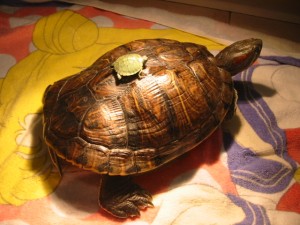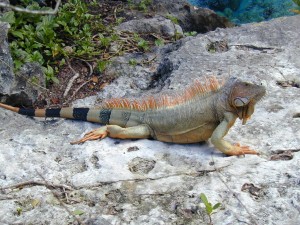Okay, here we go again! Now it’s time for some species specifics on a few of the more common released pets that can turn into invasive species. You’ve probably seen or even had some of these animals sometime as they’re pretty common in the pet trade. This is Part 3 kiddos, so if you want a recap of our earlier fun click here for Part 1 or Part 2. Or click here just because it has nothing to do with anything. 🙂
Red Eared Slider turtles are one of the most common reptile pets on the market today. Actually, it is against the law to sell a turtle with a shell length of less than 4″, except for educational or research purposes. This is unfortunately not a heavily enforced law, as I see droves of baby turtles sold in shops by the beaches. In NC it is illegal to buy or sell any size and species of turtle or tortoise, though you may have as many as you wish. But I cannot even count the number of people who go to Myrtle Beach SC for the weekend and come back with a baby slider or two. Never a good idea.

The males get about an 8″ shell length, the females can get to over a foot long. Too large for most general pet keepers. The old wives’ tale of keeping it in a smaller tank so it won’t grow is a horrible fallacy. True, it won’t grow to it’s full potential, but the poor animal is being stunted and will develop bone and growth issues and have a very shortened life because of it. It will generally get just a bit too big for it’s container and then become completely stunted. These turtles need plenty of room to swim and move, with UV lighting or natural sunlight (many people do not want to pay for the expensive UV bulbs, and so more health problems arise). They also are a messy species and eat a variety of foods as well as necessitating vitamins to grow their shells and bones properly. The little turtle that was bought for $5 at the beach can become an undertaking of many hundreds of dollars throughout it’s life.

Green Iguanas are a huge handful to have to deal with, and many years ago when they were very expensive and uncommon it was not a huge problem. But over the past decade and a half, their prices have dropped significantly and now there are baby iguanas everywhere for less then $20. Some places even have the horrible practice of giving them away as prizes at carnival games. I would venture a guess that at least 90% of these baby iguanas perish terribly before they are even out of the juvenile stage. If not, then many more will have various bone diseases and other afflictions due to the specialized dietary needs and other care necessities that this species requires to grow to a large and healthy size and that most general pet keepers are remiss in providing. A common green iguana can get to 6 feet long, are arboreal (tree climbing) in nature and are for the most part vegetarian. They need a wide array of vegetables, fruits, leafy greens and vitamin supplements, as well as high exposure to UV lighting and a hot basking spot. Plus a whole lot of room to move and grow in. If handled properly they can become a fairly docile pet, but sometimes the males as they attain a larger size and sexual maturity can become aggressive. They are attempting to be the dominant animal and will turn on humans and iguanas alike to attain that. Once iguanas pass about 3 feet long, many owners start looking for a new home for them.

These animals are only going to continue to grow, and most zoos, pet store and rescue organizations are already glutted with unwanted pets. So the desperate owner unfortunately will turn to an easy option and one which most people mistakenly talk themselves into thinking is the best thing for the animal and that’s releasing it. This is a huge problem with iguanas, as any climate colder than Florida will kill them, and if they are in Florida they have become an established and invasive species which breeds readily, and are now occupying a good bit of the tropical habitats in the state. Many times alongside humans. They live in parks, wooded areas in cities, and I have even seen them in dense numbers at an RV park along a canal where they would run and dive into the water to swim away if approached by humans or any other threats.
A good number of exotic tropical fish are also on the list of problem species that get dumped into the waterways when they inevitably outgrow their tanks. Some people can handle very large fish in their homes, most cannot. Yet still they buy them anyway because they’re “cool”, or they want to watch them eat other fish or a whole other host of bad reasons. Oscars are a large South American fish from the cichlid family. They are very attractive fish, kind of a bully and will swallow anything they get their mouth around. Oh, and they get about the size of my boot. I’m a size 12, so a pretty decent size fish.

Pacus are related to Piranhas (although primarily a plant eater in nature) but get to a diameter reminiscent of a small car tire. Lionfish are a saltwater species who possess venomous spines and a voracious appetite and have practically no natural predators along our coastline where they are occurring more and more frequently.

And of course Snakeheads. These fish were brought in not only for the pet trade, but also for the food industry. They are considered a delicacy in Asia. Most species can get at least a meter long, have a large toothy mouth, will eat anything they can overpower and can move across wet land and gulp air to find and colonize new bodies of water. So once everything in an area is eaten, it’s on to the next place. And once a breeding population is established, they can spread out from there and quickly decimate an entire ecosystem.
These are just a few of the species that were commonly kept and have ended up running amuck in various parts of the South Eastern wilderness or waterways. If you happen to have one or are contemplating obtaining one, do your best to keep it it’s entire life because that’s what responsible owners do. If for some reason you are unable to, find it a good home somewhere and don’t let it loose. You never know, one day we might be overrun with a new complement of species that really become a problem. Honestly people, if we’re going to be overrun with things, at least make it something worthwhile. Like Anne Hathaway (Helloooooo Nurse!) 🙂

If people are interested in obtaining a turtle there are many organizations out there that work with adoption and rescue of these species. However, I STRONGLY urge people to do tons of research because like Mikey stated, they cost a huge amount of money and time to keep. Their diets are diverse and there is vet upkeep as well.
They are so cute when they are baby hope mine doesnt grow that big